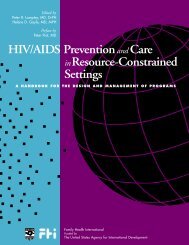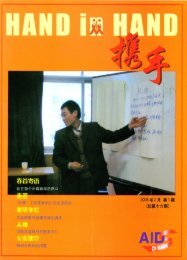The Training of Trainers Manual - UNFPA
The Training of Trainers Manual - UNFPA
The Training of Trainers Manual - UNFPA
You also want an ePaper? Increase the reach of your titles
YUMPU automatically turns print PDFs into web optimized ePapers that Google loves.
Day 3<br />
<strong>Training</strong> topic<br />
Role play again<br />
Objective <strong>of</strong> the session<br />
To build participants’ skills in using role plays, a technique that is <strong>of</strong>ten used in<br />
peer education.<br />
Exercise: Triads – competing for attention<br />
Objective<br />
To practise listening and giving selective attention through role play<br />
Materials Three chairs<br />
Process<br />
Ask the participants to sit in a semicircle. Place the three chairs side by side and<br />
slightly removed from the participants. Ask three volunteers to sit in the chairs<br />
facing the rest <strong>of</strong> the group.<br />
Begin the exercise by saying: ‘<strong>The</strong> person sitting in the centre <strong>of</strong> the three chairs is<br />
the “listener”, whose job is to try to listen and be attentive to the people on both<br />
sides. <strong>The</strong> person in the chair on the right must continually try to attract and keep<br />
the listener’s attention. Do this by telling the person in the center about some<br />
problem that you make up. <strong>The</strong> person in the chair on the left must also try to<br />
keep the listener’s interest and attention by telling the listener about your job, the<br />
wonderful, amazing job you have that you love so much. You can make up any<br />
kind <strong>of</strong> job you want. Neither <strong>of</strong> the people trying to get the listener’s attention<br />
should pay attention to the other one, but focus only on the listener.’<br />
30-40<br />
minutes<br />
Also suitable for<br />
training <strong>of</strong><br />
peer educators<br />
All participants in the group rotate through all three positions in sequence,<br />
moving over one seat at a time as in a big, moving circle. During this activity,<br />
you may help a participant whom you think needs some coaching – for example,<br />
encouraging him or her to try harder to capture the listener’s attention. You can<br />
also stop the game temporarily to demonstrate how to work very hard to get the<br />
listener’s attention. This might involve turning up the emotional ‘volume’, such as<br />
by showing how desperate you are to capture the listener’s attention.<br />
Section 2. Guidelines for <strong>Training</strong> <strong>of</strong> <strong>Trainers</strong><br />
81

















